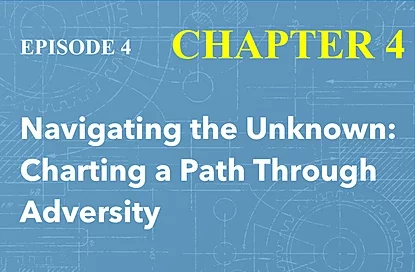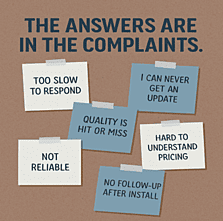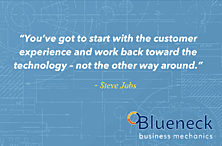The Leader's Quest: A World in Flux
Episode 4: Navigating the Unknown: Charting a Path Through Adversity
Article 4: Customer Insights in Action: The Door to Innovation


What Are You Missing?
In fast-changing markets, innovation doesn’t always start with a brilliant idea, it often starts with a better question. Instead of asking customers what they want, what if you asked what they don’t want?
Carlos owns a custom cabinetry business in a mid-sized town. Business was steady, but it felt like he was always playing catch-up … chasing what competitors were doing or guessing what clients wanted.
At a routine consultation, he shifted his approach and asked a simple question: “What frustrates you about your current supplier?”
The answer was immediate and honest: “I hate the wait time. And I never really know what I’m getting until it shows up.”
That one comment was a game-changer and sparked a new service: Carlos launched a new interactive digital design preview and guaranteed feedback within 24 hours. Suddenly, Carlos wasn’t just building cabinets. He was building trust and word-of-mouth was driving more business than his ads ever had.
Have you ever been surprised by what your customers don’t say?
This challenge — figuring out what your customers really want by listening to what they don’t — is a turning point for many small businesses. Your edge isn’t always about being the best. It’s about being the most responsive. This article explores how better listening, not louder marketing, can lead you to the next right move.
Click on the right/left arrows to read the rest of the article.

"Tell Us What You Think" Doesn’t Cut It Anymore
Most businesses ask for feedback to confirm they’re on the right track—but that only tells part of the story. If you’re only listening to happy customers or asking what people like, you’re missing what really matters: what’s not working, what’s frustrating, and what’s going unsaid.
Especially during times of change, those overlooked complaints are gold. The smartest businesses aren’t just asking for feedback, they’re digging into why customers feel the way they do, spotting friction early, and testing new ideas that overcome them quickly. Because your next great idea won’t come from a brainstorming session, it’ll come from your buyer.
Here’s what trips up many businesses:
- They ask what customers want, but not why they want it.
- They gather feedback. but don’t test new ideas fast enough to act on it.
- They assume loyalty but ignore pain points that slowly drive customers away.
If you want to stay relevant, don’t just react, identify actual solutions with your customers. When done right, listening becomes more than a feel-good gesture. It becomes your secret weapon for staying ahead.
We used to rent movies on VHS tapes, then DVDs, then high-definition formats. While the big players were busy improving picture quality, one small company focused on a different frustration — showing up to rent a movie only to find it out of stock, then getting hit with late fees. That company was Netflix. By solving the real pain point, they changed the game with digital streaming.
So how do you start asking the right questions?
Click on the right/left arrows to read the rest of the article.

Quit Guessing, Start Listening
If you’re still asking customers, “What do you want?”, you might be asking the wrong question. The magic often lies in digging deeper: What’s bugging them? What’s missing? What would make them switch?
Instead of guessing what will sell or improve loyalty, start asking sharper questions that uncover what people really need (or can’t stand). Think less “How do you like us?” and more “What drives you nuts about the other guys?”
Here are a few questions that can open the floodgates:
- Product Fit: Are you solving new customer problems, or just polishing an old solution?
- Pain Points: What do your customers dislike about current options and why?
- Early Testing: Have you tried a simple version of the idea to get feedback?
- Customer Experience: Are you asking about the buying journey, not just the product?
- Future Trends: What are your best customers starting to need (but haven’t asked for yet)?
A few smart questions now can save you from big (and expensive) blind spots later. But once you’ve got better answers, what should you do with them?
Click on the right/left arrows to read the rest of the article.

Bold Moves Begin With Better Listening
If you want better results, start by asking better questions. The businesses that stay ahead aren’t always the biggest or fastest — they’re the ones who listen, adjust quickly, and try new ideas without overthinking it.
While the big car companies were focused on building better back-up cameras, smaller companies zeroed in on a different need: drivers who wanted to protect themselves with proof. That’s how the dashcam market took off and is now worth about $6 billion annually and growing at about 20% per year.
Start with these three simple shifts:
- Reframe: Start listening for what’s missing, not just what’s liked.
- Refocus: Skip the big surveys. A quick check-in or casual conversation can uncover more useful insight.
- Reimagine: Let a few trusted customers give feedback on early ideas. It’s easier (and cheaper) to test and tweak now than fix something later.
You don’t need to be perfect—you just need to keep moving.
💡 Real-time feedback leads to smarter decisions. Listen for what’s not working and try something new before your competitors do.
Click on the right/left arrows to read the rest of the article.

Insight to Action: 5 Step Playsheet
You don’t need a big budget or fancy tech to turn customer feedback into better products or services. You just need to listen closely and try small changes that make a big difference. Here’s a down-to-earth playsheet to help you do just that:
1. Flip the Script
Stop asking, “What do you want more of?” and try, “What do you want to deal with less?”
💡Tip: Add “What do you wish this product or service did different?” to your next customer call or follow-up email.
2. Sketch, Don’t Build
Before you spend money, test a rough version of your idea. It can be as simple as a paper sketch or photo mock-up.
💡 Tip: Use free tools or quick drawings to get feedback before you commit.
3. Involve Your Best Customers
Invite a few trusted clients to test new ideas early. People love being part of the process and they’ll tell you what works.
💡 Tip: Offer a small discount or thank-you gift for their honest input. Better yet, give a sample away for free.
4. Keep a Feedback Log
Don’t rely on memory — track what customers are saying across emails, calls, or job sites.
💡 Tip: Create a shared notes file or whiteboard to jot down repeated feedback and ideas.
5. Work Backward from Problems
Look at where things go wrong, returns, complaints, delays — and trace the root cause.
💡 Tip: Ask your team, “Where did this go off track for the customer, why did it happen, and what could we do differently next time?”
Innovation doesn’t have to be expensive or complicated. By asking better questions, trying out low-cost ideas, and learning from real customer feedback, small businesses can stay ahead, without the guesswork. Start small, listen closely, and build smarter from there.Simple changes now can lead to better results tomorrow.
Click on the right/left arrows to read the rest of the article.


Ready to Build What Your Customers Want?
Customer needs are changing fast. What worked a year ago might already feel outdated but that doesn’t mean you’re falling behind. It means you’ve got a chance to listen closer and adjust smarter.
This article shared how asking better questions, digging into frustrations, and testing small ideas can help you stay ahead, without spending a fortune. When you listen for what’s missing, not just what’s working, you open the door to real improvements.
So here’s the big question: What haven’t you asked your customers yet — but should?
At Blueneck, we help small businesses uncover those answers and turn insight into action.
Let’s build what’s next — together.
Episode 4: Navigating the Unknown
Genghis Khan transformed warfare by adding stirrups—small change, big impact. What “stirrups” could move your business forward? Next week, learn how to spot the right tools and innovations to lead with clarity and confidence. It’s not just about keeping up — it’s about choosing the right path forward.
Read More Articles
As 2025 progresses, we will be unveiling 45 unique articles to help leaders unlock opportunities in an uncertain world!

